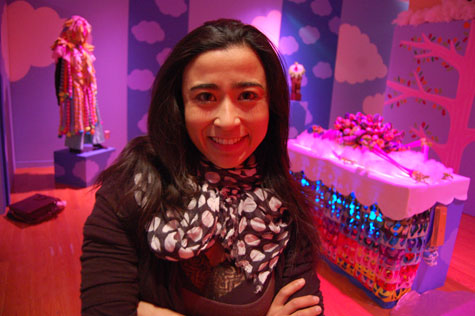
EMPATHIC DREAM BOX A rumination on how human beings could biologically, spiritually, collectively become something they desire to be. |
“SAYA WOOLFALK: THE INSTITUTE FOR THE ANALYSIS OF EMPATHY” | Tufts University Art Gallery, 40R Talbot Ave, Medford | Through April 4 |
Saya Woolfalk first grabbed people's attention around 2005, with playful-serious installations and videos in which performers masked in bright, patchwork fabric costumes of cartoon leaves and long swinging dreadlocks jumped around small rooms decorated like cartoon paradises.
Woolfalk had studied art and economics at Brown University in Providence, graduating in 2001, the year the Providence art collective Fort Thunder broke apart when a developer tore down the old mill that had housed it to build a shopping plaza. The pop psychedelic posters, comics, installations, and masked performances by that gang and affiliated collectives like Hive Archive and Dirt Palace were everywhere in Providence then, and busting out nationally. (Fort Thunder offshoot Forcefield presented a giant monster mannequin installation at the 2002 Whitney Biennial.) And you can feel this influence in Woolfalk's costumes, imagined narratives, and Rainbow Brite colors.
But her art also sprang from her background as a black-white Japanese-American who grew up in predominantly white Westchester, New York. "I've always been . . . someone in between," the 30-year-old New Yorker tells me. She merged Providence's bright, childlike æsthetic with inspiration she drew from Carnival in Brazil, African-diaspora faiths, and Japanese butoh dance. Her pieces were presented with little explanation, but the results felt like re-enactments of the uncomfortable history of relations between the Western avant-garde and traditional African art . . . turned into an amazing private dance party by Yo Gabba Gabba!
Woolfalk's new installation, "The Institute for the Analysis of Empathy," at the Tufts University Art Gallery sketches out a backstory. It begins with her 2008 Ethnography of No Place video. Animations recount an anthropologist's sail down a pink river past technicolor islands, crystal palaces, and an all-seeing eye atop a pyramid. Live-action performers in patchwork costumes of rainbow flowers and leaves (five of the costumes are displayed in the gallery) perform ritualistic dances representing pollination, offerings, and birth.
The tale is elaborated in this year's Empathic Dream Box video installation, with its animations of a factory on a cloud that manufactures hearts, masks tumbling into underground canals, a woman's veins sprouting leaves. Live-action performers clad in plain, skin-tight bodysuits (this time their faces are not hidden) dance in a dark room, bending around a large circle on the wall, striking poses, carrying a rainbow-hued skeleton and bowing toward it.
Woolfalk clarifies the story a bit, telling me, "Women in the woods of upstate New York find the bones of a No Placean, they're the people from the future." The No Placeans — who it seems are also called Empathics — are part-plant, part-human creatures with skin like earth, a pelt of flowers and leaves, and a "supernatural and biological connection to a future utopian world" dubbed No Place, from the Greek root of the word utopia. A drawing diagrams their skeleton and nervous system, which "is fed by energy central to all living things." The bones, displayed on a pedestal here, mutate the women's genetic materials to make them more like the No Placeans. This becomes apparent in the video when a naked woman lies atop the half-buried skeleton and her body flashes light.